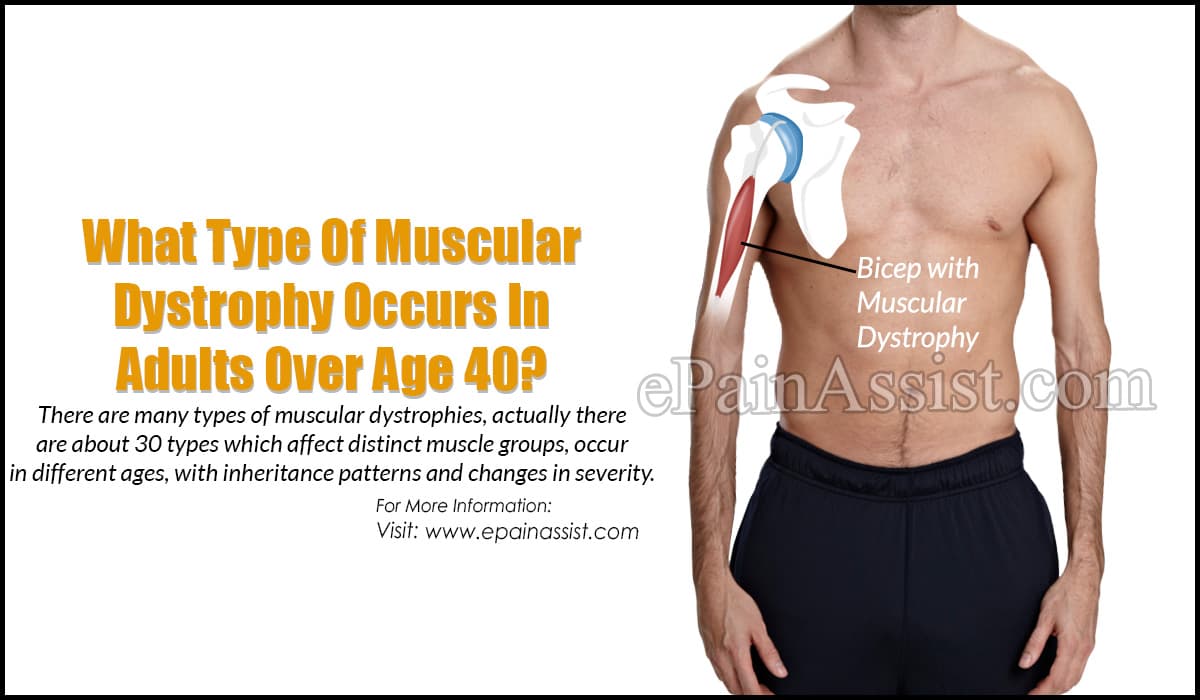There are many types of muscular dystrophies, actually there are about 30 types which affect distinct muscle groups, occur in different ages, with inheritance patterns and changes in severity. Some types of muscular dystrophy (MD) are very rare.1 Most of the muscular dystrophies occur during childhood or during teenage years. There are few muscular dystrophy types that occur over the age of 40 years.

Distal Muscular Dystrophy
Distal muscular dystrophy (DMD) is a type of muscular dystrophy that affects the distal muscles of the body such as the forearm, hands, legs and feet.1 There is wasting and weakness seen in these muscle groups. It is a rare type of muscular dystrophy; the inheritance is autosomal dominant or recessive. The mutation is in the protein dysferlin and it can occur in both males and females.
It usually occurs between the ages of 40 and 60 years, but it can occur anytime in life from infancy to adulthood. DMD is a less severe type of muscular dystrophy and the progression of the disease is slow compared to the other types of muscular dystrophy.
There several types of DMD like distal myopathy, distal myopathy with rimmed vacuoles, distal myopathy with vocal cord and pharyngeal signs, inclusion body myopathy type 2, laing distal myopathy, laing early-onset distal myopathy, tibial distal myopathy, welander distal myopathy. Inheritance is autosomal dominant inheritance or recessive.
Symptoms, severity and progression differ according to the type of DMD, usually muscle wasting and weakness is present in distal muscles, and in some types this can progress and involve the proximal muscle as well. There is no cure for DMD; treatment is directed to reduce the symptoms.
Oculopharyngeal Muscular Dystrophy
Oculopharyngeal muscular dystrophy (OPMD) affects the upper eyelids and throat muscles.1 It’s a rare type of muscular dystrophy; it affects both males and females who are between the ages of 40-50 years. The inheritance is autosomal dominant or recessive, autosomal dominant form is more common than the recessive form. The mutation is in the protein that binds to molecules to help other proteins bind to the molecule.
Upper eyelids and throat muscles are involved initially and the first symptoms that occur are drooping eyes (ptosis) and difficulty in swallowing (dysphagia). The progression of the disease is very slow, but as the disease progress there can be weakness and wasting in the neck muscles and upper limbs. Some types of OPMD involves the lower limbs as well, these people have difficulty in walking. Sometimes it involves the heart muscles and cause heart disease. No specific treatment, only symptomatic treatment.
Facioscapulohumeral Muscular Dystrophy
Facioscapulohumeral muscular dystrophy (FSHMD) affects the muscles of the face, shoulder blade (scapula) and upper arm (humerus).1 This usually occurs in teenage boys and girls but it sometimes occurs in males and females above 40 years.
The initial symptoms occur in the eyes with difficulty to open and close the eyes, then in the mouth with difficulty to smile or pucker. Weakness of the shoulder blade muscles give rise to winging scapula, weakness in the upper arms cause difficulty in moving the arm. Some people have difficulty in swallowing, speaking and hearing problems. Most FSHMD have a normal life span, it rarely affects the heart and respiratory muscles and the disease progression is very slow.
Summary
There are about 30 types muscular dystrophies (MD) only a few muscular dystrophy types that occur over the age of 40 years. Distal muscular dystrophy (DMD) is a type of MD that affects the distal muscles of the body such as the forearm, hands, legs and feet. It usually occurs between the ages of 40 and 60 years but it can occur anytime in life from infancy to adulthood. Oculopharyngeal muscular dystrophy (OPMD) affects the upper eyelids and throat muscles. It’s a rare type of muscular dystrophy; it affects both males and females who are between the ages of 40-50 years.
Facioscapulohumeral muscular dystrophy (FSHMD) affects the muscles of the face, shoulder blade (scapula) and upper arm (humerus). This usually occur in teenage boys and girls, but it sometimes occur in males and females above 40 years.
Also Read:
- How Do You Slow Down Muscular Dystrophy?
- Is There Any Treatment For Muscular Dystrophy?
- What Is The Prognosis For A Person With Muscular Dystrophy?
- Can Muscular Dystrophy Be Detected During Pregnancy?
- Can Older People Get Muscular Dystrophy?
- What Are The First Signs Of Muscular Dystrophy?
- What Not To Eat When You Have Muscular Dystrophy?
